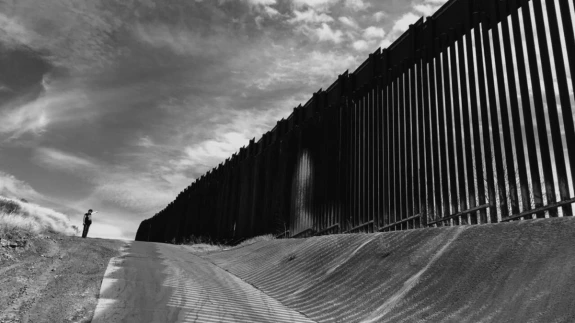
Courses
Given the UA’s proximity to the Mexican border, and the fact that half the faculty members have international reporting experience, the school has carved out a specialty in global reporting that provides students an enticing array of global reporting classes.
An elective that enables UA students to meet for class weekly in Nogales, Arizona, and cross into Mexico. Students will gain an understanding of best practices and challenges specific to reporting in the borderlands, and will conduct research in and about the border region, including interviews with area residents. They will report findings in the form of essays, oral histories, research projects and in-depth reporting project.
Taught by Celeste Gonzalez de Bustamante, explored the history, politics, economy and culture of Latin America and its media systems, with a focus on Mexico. In March 2013, during spring break, six students in the class traveled to Mexico City to participate in a weeklong colloquium featuring media experts and professionals, and tours of major media outlets including Televisa and Reforma. On their return from Mexico City, the group toured the El Imparcial newsroom in Hermosillo, Sonora. Students produced multimedia news reports and research papers about media and Mexico.
This course offers a study of world news systems, including news gathering agencies, the role of foreign correspondents, the foreign press and the factors influencing the flow of international news. Mort Rosenblum, former editor of the International Herald Tribune and globe-trotting correspondent for the Associated Press for four decades, has taught the class since 2006. He is the co-director of the Center for Border & Global Journalism at the UA School of Journalism.
Taught by Professor Maggy Zanger, this elective focuses on how international media cover conflicts and other humanitarian crises, in the Arab/Muslim world.
Taught by Zanger, provides students with an understanding of current events in the Middle East and of the challenges journalists face reporting from a region with competing narratives, authoritarian regimes, and sporadic or ongoing conflict.
This course focuses on how news media portray terrorism and terrorists, and how the media’s coverage affects the public.
This course analyzes the history of Latinxs in the United States. Students will also examine the history of Latino-oriented, Spanish-language and bilingual news media, as well as news coverage of Latinos and Spanish-speaking communities in the U.S.
This course introduces the study of migrations, diasporic transnationalism and the media in Latin America. Students will examine historical perspectives and contemporary trends on migration from Latin America to Europe, Asia and North America (South-North) as well as migrations within Latin American (South-South).
This course focuses on the practice of bilingual journalism in Latinx communities. As the first in a series of two skills courses, it emphasizes bilingual multimedia writing and audio production. Working in teams, students will conduct interviews, write audio scripts and produce podcasts or radio pieces in Spanish and English—and Portuguese, when applicable. This class includes lectures, readings and practical experience in the field. To the extent possible, the classroom will function as a newsroom.
This course focuses on the practice of bilingual journalism in Latinx communities. As the second in a series of two skills classes, it emphasizes bilingual multimedia writing and video production. Students will be encouraged to look for new models of producing high-quality journalism. This class includes lectures, readings and practical experience in the field. To the extent possible, the classroom will function as a newsroom.
This course investigates the history and coverage of acts of state and nonstate terror, the interplay between terrorism and societies around the world and media content about acts of terror. Students explore how news media portray terrorism and terrorists, the effects of terrorism and media portrayal of terrorism on the public and the use of propaganda by terror groups and other entities.
The course focuses on crafting and promoting media content in ways that seek to develop and monetize global networks of influence. Rather than assuming mass audiences wait passively for content, this course covers audience development including audience engagement tracking. This studies of global media course also discusses the history of audience research and broad concepts having to do with the global attention economy. Finally, it covers in some depth how to conduct a critical analysis of the potential social ramifications of building online audiences at scale. Globally, vast networks of people have been mobilized for good and for ill by means of engaging them with verified information and misinformation. This course addresses head on the dichotomy of the need for global media professionals to develop audiences in online networks using influencer-like practices while also paying attention to the many reasons why we do not feed the trolls.
This course surveys the history and functions of social justice media from the 19th century abolition movement to today’s online forms of global social justice journalism. Students consider the theoretical and practical frameworks of social justice media, which serve a swathe of social movements involving human and civil rights, education, labor, immigration, globalization, feminism, environmentalism, ethnic and racial equality, transgender rights and global inequity.
Students explore ethics questions related to cultural bias, political and economic pressure, diverse representation, accuracy, privacy, national security and other pressures on news media. This course provides students with a framework to think critically about media’s obligations to the public. Analyses examine ethical philosophies as they relate to both citizen-driven media and journalists’ roles and responsibilities in various societies and governmental systems around the world.
This course examines the rapidly shifting arena of armed conflict and political violence in an intensively and expansively mediated era. Students explore traditional journalistic business, culture and ethics in covering war and the more recent impact of technological transformations, focusing on new digital and social media forms employed by multiple actors and stakeholders.

